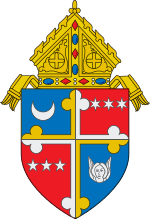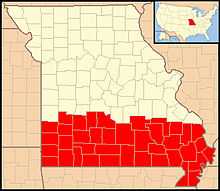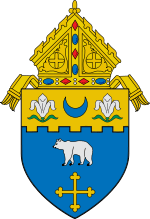William Wakefield Baum
| His Eminence William Wakefield Baum | |
|---|---|
| Major Penitentiary Emeritus of the Apostolic Penitentiary | |
| See | Santa Croce in Via Flaminia |
| Appointed | April 6, 1990 |
| Term ended | November 22, 2001 |
| Predecessor | Luigi Dadaglio |
| Successor | Luigi de Magistris |
| Other posts | Cardinal-Priest of Santa Croce in via Flaminia |
| Orders | |
| Ordination |
May 12, 1951 by Edwin Vincent O'Hara |
| Consecration |
April 6, 1970 by John Carberry |
| Created Cardinal |
May 24, 1976 by Paul VI |
| Rank | Cardinal-Priest |
| Personal details | |
| Birth name | William White |
| Born |
November 21, 1926 Dallas, Texas |
| Nationality | American |
| Denomination | Roman Catholic |
| Previous post |
|
| Motto |
Ministerium reconciliationis (The ministry of reconciliation) — 2 Corinthians 5:18 |
| Coat of arms |
 |
| Styles of William Baum | |
|---|---|
 | |
| Reference style | His Eminence |
| Spoken style | Your Eminence |
| Informal style | Cardinal |
| Ordination history of William Wakefield Baum | |
|---|---|
Episcopal consecration | |
| Principal consecrator | John Carberry (St Louis) |
| Date of consecration | April 6, 1970 |
Bishops consecrated by William Wakefield Baum as principal consecrator | |
| Thomas William Lyons | September 12, 1974 |
| Eugene Antonio Marino | September 12, 1974 |
William Wakefield Baum (born November 21, 1926) is an American cardinal of the Catholic Church. He served as Bishop of Springfield-Cape Girardeau (1970–73) and Archbishop of Washington (1973–80) before serving in the Roman Curia as Prefect of the Congregation for Catholic Education (1980–90) and Major Penitentiary (1990–2001).[1] He was elevated to the College of Cardinals in 1976, and is currently the longest-serving American cardinal in history.[2]
Early life and education
William Wakefield White was born in Dallas, Texas, to Harold E. and Mary Leona (née Hayes) White.[3] His father, Presbyterian, died when William was a young child, and he and his mother subsequently moved to Kansas City, Missouri.[4] His mother married Jerome Charles Baum, a Jewish businessman, who adopted William and gave him his last name.[5]
He received his early education at the parochial school of St. Peter's Church, and began to serve as an altar boy at age 10.[6] He entered St. John's Minor Seminary in 1940, and then studied philosophy at Glennon College in St. Louis.[5] In 1947, he entered Kenrick Seminary, also in St. Louis, for his theological studies.[6]
Priesthood
Baum was ordained to the priesthood by Archbishop Edwin V. O'Hara on May 12, 1951.[1] His first assignment was as assistant pastor of St. Aloysius Church in Kansas City.[7] He taught theology and Church history at St. Theresa College from 1954 to 1956, as well as at St. Aloysius Academy and Glennon High School.[4] He then furthered his studies at the Pontifical University of St. Thomas Aquinas, Angelicum in Rome, where he earned a Doctorate of Sacred Theology degree in 1958.[3] His thesis was entitled: "The Teaching of Cardinal Cajetan on the Sacrifice of the Mass".[4]
Returning to Kansas City, Baum resumed his teaching duties at St. Theresa College (1958–63) and served as secretary of the Diocesan Tribunal.[5] He also did pastoral work at St. Theresa's Church and St. Peter's Church, both in Kansas City.[6] In 1960, he became pastor of St. Cyril's Church in Sugar Creek.[5] He published "Considerations Toward the Theology of the Presbyterate" in 1961.[8] He was named a papal chamberlain by Pope John XXIII in April 1961, and vice-chancellor of the Diocese of Kansas City-St. Joseph in 1962.[3]
From 1962 to 1965, Baum served as a peritus, or theological expert, to Bishop Charles Helmsing at the Second Vatican Council.[6] In that capacity, he worked with the Secretariat for Christian Unity and helped draft Unitatis Redintegratio, the Council's decree on ecumenism.[5] In 1964, he was named the first executive director of the Committee on Ecumenical and Interreligious Affairs for the National Conference of Catholic Bishops, a post which he held for five years.[8] He also served as a member of the Joint Working Group of representatives of the Catholic Church and World Council of Churches (1965–69) and of the Mixed Committee of representatives of the Catholic Church and the Lutheran World Federation (1965–66).[6]
In 1967, Baum returned to Kansas City, where he served as chancellor of the diocese and pastor of St. James Church.[7] He was named a domestic prelate in 1968.[3]
Episcopal ministry
Bishop of Springfield-Cape Girardeau
On February 18, 1970, Baum was appointed the third Bishop of Springfield-Cape Girardeau by Pope Paul VI.[1] He received his episcopal consecration on the following April 6 from Cardinal John Carberry, with Bishops Charles Helmsing and Joseph Sullivan serving as co-consecrators.[1] He selected as his episcopal motto: "Ministry of Reconciliation" (2 Corinthians 5:18).[8]
He served as an American delegate to the World Synod of Bishops at the Vatican in 1971, and was chairman of the Bishops' Committee for Ecumenical and Interreligious Affairs (1972–75).[3]
Archbishop of Washington
Three years later Paul VI elevated him to Archbishop of Washington, D.C. (his successor in Springfield-Cape Girardeau being Bernard Francis Law, another future cardinal); and in the consistory of 1976 Baum was named Cardinal-Priest of S. Croce in via Flaminia. He participated in the two conclaves of 1978.[9]
Career in the Roman Curia
Under Pope John Paul II, Baum's rise continued, as in 1980 he was named to the Roman Curia as Prefect of the Congregation for Catholic Education. In 1990 he became the Church's Major Penitentiary, exchanging the responsibility of overseeing church seminaries worldwide for that of supervising the office in charge of the forgiveness of sins.
Baum was one of the cardinal electors who participated in the 2005 papal conclave that selected Pope Benedict XVI. Along with Benedict (then Cardinal Ratzinger) and Cardinal Jaime Sin, Baum was one of three remaining cardinals elevated by Paul VI to retain voting rights in that conclave. Cardinal Baum was the senior Cardinal Priest to participate in the 2005 papal conclave.[10]
Later life
Somewhat frail in recent years, Cardinal Baum has suffered from deteriorating eyesight. His resignation as Penitentiary was accepted the day after his 75th birthday in 2001, but he remained active in Rome to the extent that his health permitted, and attended the meeting of American cardinals called to deal with the sex abuse scandal in 2003. He now resides in Washington, D.C.
With the election of Ratzinger as pope on April 19, 2005, followed by the death of Cardinal Jaime Sin on June 21, 2005, Baum became the last cardinal elevated by Pope Paul VI to maintain voting rights in a papal conclave. Upon Baum reaching the age of 80 on November 21, 2006, all cardinals who may vote in a conclave had been elevated by Pope John Paul II or Pope Benedict XVI.
On March 8, 2011, Baum surpassed James Gibbons of Baltimore to become the longest-serving American cardinal of all time.
References
- ↑ 1.0 1.1 1.2 1.3 "William Wakefield Cardinal Baum". Catholic-Hierarchy.org. David M. Cheney. Retrieved 21 January 2015.
- ↑ Weigel, George (2011-03-16). "Cardinal Baum: A New Record-Holder". First Things.
- ↑ 3.0 3.1 3.2 3.3 3.4 Miranda, Salvador. "BAUM, William Wakefield (1926– )". The Cardinals of the Holy Roman Church.
- ↑ 4.0 4.1 4.2 Onofrio, Jan (1996). Texas Biographical Dictionary I (III ed.). New York: Somerset Publishers, Inc.
- ↑ 5.0 5.1 5.2 5.3 5.4 Denzer, Marty (2011-06-02). "Cardinal William Baum, 60 years a priest". The Catholic Key.
- ↑ 6.0 6.1 6.2 6.3 6.4 "William Cardinal Baum". Roman Catholic Archdiocese of Washington.
- ↑ 7.0 7.1 "BAUM Card. William Wakefield". Holy See.
- ↑ 8.0 8.1 8.2 "An American Proponent of Ecumenism". The New York Times. 1976-04-28.
- ↑ "William Wakefield Baum". Catholic-Hierarchy.org. David M. Cheney.
- ↑ http://www.fiu.edu/~mirandas/bios-b.htm#Baum
| Catholic Church titles | ||
|---|---|---|
| Preceded by Ignatius Jerome Strecker |
Roman Catholic Bishop of Springfield-Cape Girardeau 1970–1973 |
Succeeded by Bernard Francis Law |
| Preceded by Patrick O'Boyle |
Roman Catholic Archbishop of Washington 1973–1980 |
Succeeded by James Aloysius Hickey |
| Preceded by Gabriel-Marie Garrone |
Prefect of the Congregation for Catholic Education 1980–1990 |
Succeeded by Pio Laghi |
| Preceded by Luigi Dadaglio |
Major Penitentiary of the Apostolic Penitentiary 1990–2001 |
Succeeded by Luigi de Magistris |
| |||||||||||||||||||||
| |||||||||||||||||||||||||||||
|


